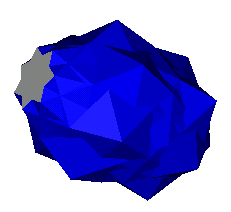
Pentakis Snub Pentaprisms
A family of chiral prismatic polyhedra which has the relationship to the snub dodecahedron that the tetrakis snub prism family has to the snub cube. The name pentakis snub pentaprism is my own. It stems from the way the polyhedra are generated.
One way to generate these polyhedra is to take a pentakis pentaprism and perform a snub operation (note that the term "pentaprism" is a compaction of the full name of "pentagonally plated anti-prism"). Triangular faces are inserted between all edges of the original pentaprism. The pentagonal pyramids are left intact, i.e. the snub operation is not perfiormed between the triangular faceas of an individual pentagonal pyramid. This model of a pentakis snub pentagonal pentaprism has the pentagonal pyramids highlighted to demonstrate the snub faces. It is the only member of the family where the pentagonal pyramids are un-distorted.
Another method of generation would be to take a snub dodecahedron. Replace ten of the pentagonal faces with the caps of pentagonal pyramids, leaving two opposing pentagons in place.
The resulting triangular band between the two base polygons is flexible, allowing the replacement of the remaining pentagonal faces with a generic n/d-gon.
The family is 6-regular with vertices (counting from the prismatic faces toward the 'equator') (A): n/d-3-3-3-3, (B): 3-3-3-3-3-3, (C): 3-3-3-3-3-3, (D): 3-3-3-3-3, (E): 3-3-3-3-3-3 and (F) 3-3-3-3-3-3. The (D) vertices being the apices of the pyramids. The existence of these "3^6" vertices means that the family is not convex (globally or locally) at any n/d.
Models have been generated for a number
of values of n and n/d. Retrograde models with n/d
< 2 have also been generated. I have so far been unable to
generate any models with n>6. Whether this is a fixed upper
limit ot this family or whether this is merely a problem of discovering
the correct way to 'fold' the (A) vertices is as yet undetermined.
Links to "highlight" models are to ones with the pyramidical faces highlighted.
Pentakis Great Retrosnub Pentaprisms
The naming convention is
getting a bit stretched here, but the above picture
is, I believe, of a polyhedron related to the uniform
polyhedron: a great retrosnub icosidodecahedron.
(See also my page on augmenting the great
retrosnub icosidodecahedron)
It is an isomorph to the pentakis snub {7/3} pentaprism,
as the great retrosnub icosidodecahedron
is to the snub dodecahedron. Examples of
this family are here:
| 7/3 | 8/3 | 9/4 | 11/4 |
There should also be a family of pentakis great inverted snub pentaprisms related to the great inverted snub icosidodecahedron, another isomorph to the snub dodecahedron, but I have as yet been unable to generate any examples.
Next: Cingulated Antiprisms
Back: To Chiral Prisms
Back: To Index